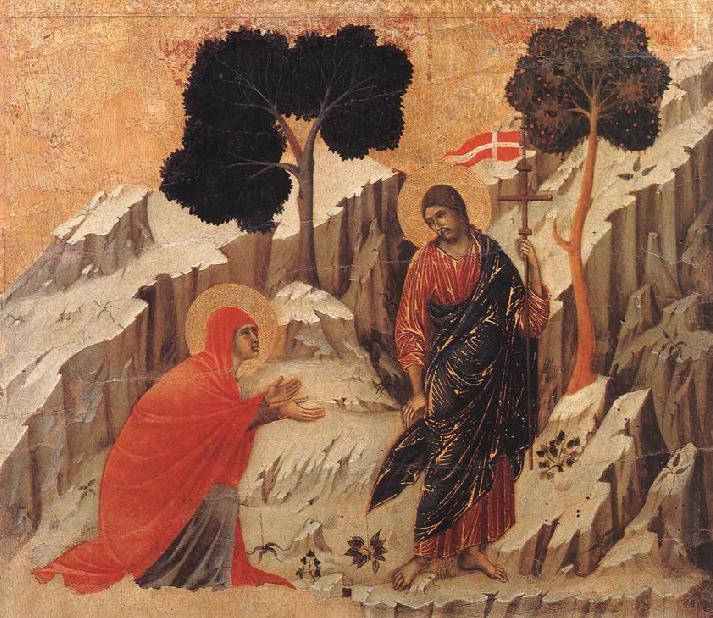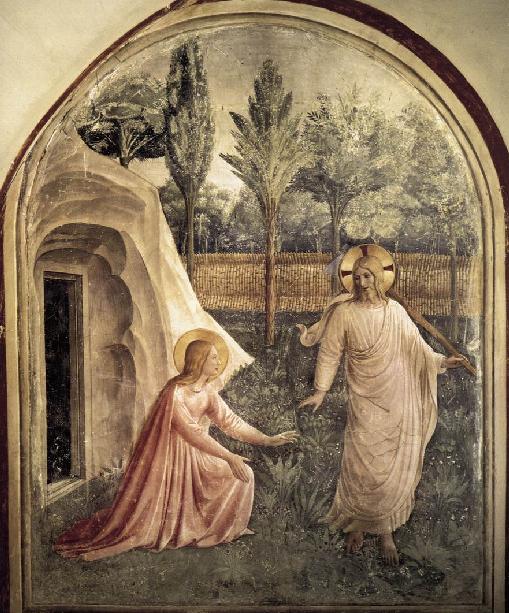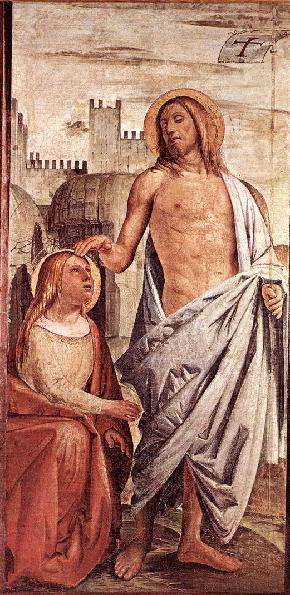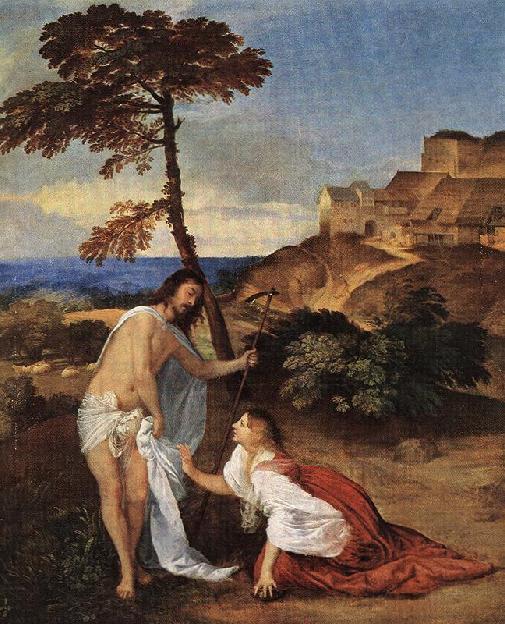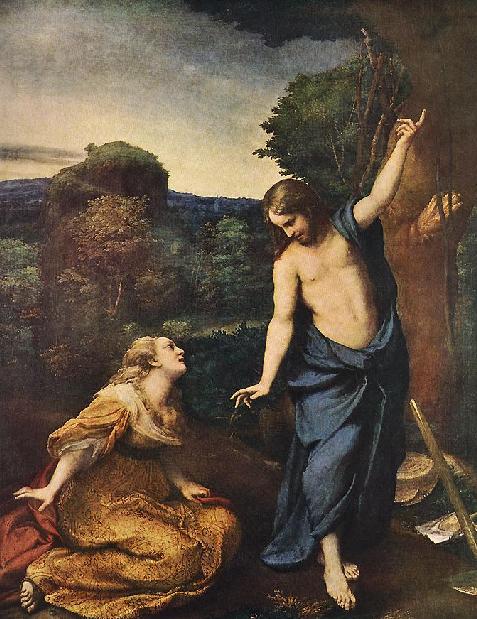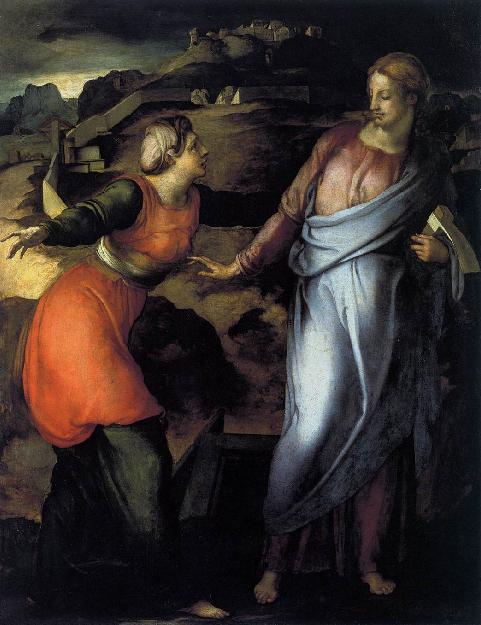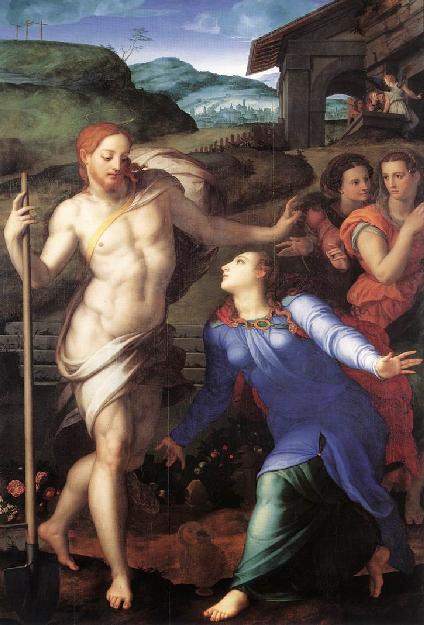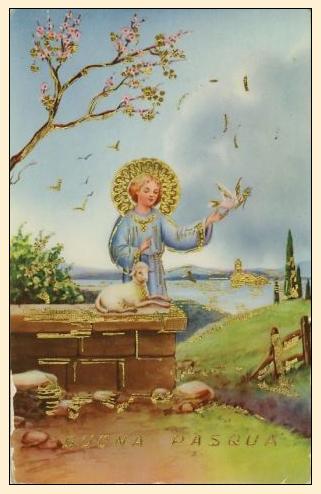
Candida Martinelli's Italophile Site

Main
Page This family-friendly site celebrates Italian culture for the enjoyment of children and
adults. Site-Overview
Giotto's
Resurrection "Noli me tangere" fresco (200 x 185 cm)
from 1304-06 in the Cappella Scrovegni (Arena Chapel), in Padua,
Italy.
Visit it if you're in the area. I enjoyed it very
much, but you need to take your time and let the initial shock of the
color and detail of the place wear off a bit. Study the details closely, like
the sleeping guards in this image. I've reproduced below the relevant passages in both Italian and
English, the King James version. The image opposite is of a painting by Giotto.
It is after Jesus rises from his tomb. He finds Mary
Magdalene crying because she believes someone has moved His body. When she recognizes Him, He tells her "Do not hold me" ("Non
mi trattenere", "Noli me tangere"), or "don't
keep me here". He's in a hurry to see the Lord, his
Father. Jesus sends Mary to prepare the Apostles for his coming visit, which
proves difficult, because they refuse to believe her. I've more 'Noli me tangere' Italian paintings
below. Giovanni 19 [38]Dopo questi fatti, Giuseppe d'Arimatèa,
che era discepolo di Gesù, ma di nascosto per timore dei Giudei, chiese a
Pilato di prendere il corpo di Gesù. Pilato lo concesse. Allora egli andò
e prese il corpo di Gesù. [39]Vi andò anche Nicodèmo, quello che
in precedenza era andato da lui di notte, e portò una mistura di mirra e
di aloe di circa cento libbre. [40]Essi presero allora il corpo di Gesù,
e lo avvolsero in bende insieme con oli aromatici, com'è usanza
seppellire per i Giudei. [41]Ora, nel luogo dove era stato
crocifisso, vi era un giardino e nel giardino un sepolcro nuovo, nel quale
nessuno era stato ancora deposto. [42]Là dunque deposero Gesù, a motivo
della Preparazione dei Giudei, poiché quel sepolcro era vicino.
Giovanni 20 [1]Nel giorno dopo il sabato, Maria di Màgdala si recò
al sepolcro di buon mattino, quand'era ancora buio, e vide che la pietra
era stata ribaltata dal sepolcro.
[2]Corse allora e andò da Simon Pietro e dall'altro
discepolo, quello che Gesù amava, e disse loro: «Hanno portato via il
Signore dal sepolcro e non sappiamo dove l'hanno posto!». [3]Uscì allora Simon Pietro insieme all'altro discepolo,
e si recarono al sepolcro. [4]Correvano insieme tutti e due, ma l'altro discepolo
corse più veloce di Pietro e giunse per primo al sepolcro. [5]Chinatosi, vide le bende per terra, ma non entrò. [6]Giunse intanto anche Simon Pietro che lo seguiva ed
entrò nel sepolcro e vide le bende per terra, [7]e il sudario, che gli era stato posto sul capo, non per
terra con le bende, ma piegato in un luogo a parte. [8]Allora entrò anche l'altro discepolo, che era giunto
per primo al sepolcro, e vide e credette. [9]Non avevano infatti ancora compreso la Scrittura, che
egli cioè doveva risuscitare dai morti. [10]I discepoli intanto se ne tornarono di nuovo a casa. [11]Maria invece stava all'esterno vicino al sepolcro e
piangeva. Mentre piangeva, si chinò verso il sepolcro
[12]e vide due angeli in bianche vesti, seduti l'uno dalla
parte del capo e l'altro dei piedi, dove era stato posto il corpo di Gesù. [13]Ed essi le dissero: «Donna, perché piangi?».
Rispose loro: «Hanno portato via il mio Signore e non so dove lo hanno
posto». [14]Detto questo, si voltò indietro e vide Gesù che
stava lì in piedi; ma non sapeva che era Gesù. [15]Le disse Gesù: «Donna, perché piangi? Chi cerchi?».
Essa, pensando che fosse il custode del giardino, gli disse: «Signore, se
l'hai portato via tu, dimmi dove lo hai posto e io andrò a prenderlo». [16]Gesù le disse: «Maria!». Essa allora, voltatasi
verso di lui, gli disse in ebraico: «Rabbunì!», che significa:
Maestro! [17]Gesù le disse: «Non mi trattenere, perché non sono
ancora salito al Padre; ma và dai miei fratelli e dì loro: Io salgo al
Padre mio e Padre vostro, Dio mio e Dio vostro». [18]Maria di Màgdala andò subito ad annunziare ai
discepoli: «Ho visto il Signore» e anche ciò che le aveva detto. [19]La sera di quello stesso giorno, il primo dopo il
sabato, mentre erano chiuse le porte del luogo dove si trovavano i
discepoli per timore dei Giudei, venne Gesù, si fermò in mezzo a loro e
disse: «Pace a voi!».
[20]Detto questo, mostrò loro le mani e il costato. E i
discepoli gioirono al vedere il Signore. [21]Gesù disse loro di nuovo: «Pace a voi! Come il Padre
ha mandato me, anch'io mando voi». [22]Dopo aver detto questo, alitò su di loro e disse: «Ricevete
lo Spirito Santo; [23]a chi rimetterete i peccati saranno rimessi e a chi
non li rimetterete, resteranno non rimessi». [24]Tommaso, uno dei Dodici, chiamato Dìdimo, non era con
loro quando venne Gesù.
[25]Gli dissero allora gli altri discepoli: «Abbiamo
visto il Signore!». Ma egli disse loro: «Se non vedo nelle sue mani il
segno dei chiodi e non metto il dito nel posto dei chiodi e non metto la
mia mano nel suo costato, non crederò». [26]Otto giorni dopo i discepoli erano di nuovo in casa e
c'era con loro anche Tommaso. Venne Gesù, a porte chiuse, si fermò in
mezzo a loro e disse: «Pace a voi!». [27]Poi disse a Tommaso: «Metti qua il tuo dito e guarda
le mie mani; stendi la tua mano, e mettila nel mio costato; e non essere
più incredulo ma credente!». [28]Rispose Tommaso: «Mio Signore e mio Dio!». [29]Gesù gli disse: «Perché mi hai veduto, hai creduto:
beati quelli che pur non avendo visto crederanno!». Source: I quote here from an on-line Italian Bible
that is no longer available. I'll keep looking for a free one
on-line.
John 19 38After this Joseph of Arimathe'a, who was a disciple of Jesus, but
secretly, for fear of the Jews, asked Pilate that he might take away the
body of Jesus, and Pilate gave him leave. So he came and took away his
body. 39Nicode'mus also, who had at first come
to him by night, came bringing a mixture of myrrh and aloes, about a
hundred pounds' weight. 40They took the body of Jesus, and bound
it in linen cloths with the spices, as is the burial custom of the
Jews. 41Now in the place where he was crucified
there was a garden, and in the garden a new tomb where no one had ever
been laid. 42So because of the Jewish day of
Preparation, as the tomb was close at hand, they laid Jesus there. John 20 1Now on the first day of the week Mary Mag'dalene came to the tomb
early, while it was still dark, and saw that the stone had been taken away
from the tomb. 2So she ran, and went to Simon Peter and the other disciple, the one
whom Jesus loved, and said to them, "They have taken the Lord out of
the tomb, and we do not know where they have laid him." 3Peter then came out with the other disciple, and they went toward the
tomb. 4They both ran, but the other disciple outran Peter and reached the
tomb first; 5and stooping to look in, he saw the linen cloths lying there, but he
did not go in. 6Then Simon Peter came, following him, and went into the tomb; he saw
the linen cloths lying, 7and the napkin, which had been on his head, not lying with the linen
cloths but rolled up in a place by itself. 8Then the other disciple, who reached the tomb first, also went in, and
he saw and believed; 9for as yet they did not know the scripture, that he must rise from the
dead. 10Then the disciples went back to their homes. 11But Mary stood weeping outside the tomb, and as she wept she stooped
to look into the tomb; 12and she saw two angels in white, sitting where the body of Jesus had
lain, one at the head and one at the feet. 13They said to her, "Woman, why are you weeping?" She said to
them, "Because they have taken away my Lord, and I do not know where
they have laid him." 14Saying this, she turned round and saw Jesus standing, but she did not
know that it was Jesus. 15Jesus said to her, "Woman, why are you weeping? Whom do you
seek?" Supposing him to be the gardener, she said to him, "Sir,
if you have carried him away, tell me where you have laid him, and I will
take him away." 16Jesus said to her, "Mary." She turned and said to him in
Hebrew, "Rab-bo'ni!" (which means Teacher). 17Jesus said to her, "Do not hold me, for I have not yet ascended
to the Father; but go to my brethren and say to them, I am ascending to my
Father and your Father, to my God and your God." 18Mary Mag'dalene went and said to the disciples, "I have seen the
Lord"; and she told them that he had said these things to her. 19On the evening of that day, the first day of the week, the doors
being shut where the disciples were, for fear of the Jews, Jesus came and
stood among them and said to them, "Peace be with you." 20When he had said this, he showed them his hands and his side. Then
the disciples were glad when they saw the Lord. 21Jesus said to them again, "Peace be with you. As the Father has
sent me, even so I send you." 22And when he had said this, he breathed on them, and said to them,
"Receive the Holy Spirit. 23If you forgive the sins of any, they are forgiven; if you retain the
sins of any, they are retained." 24Now Thomas, one of the twelve, called the Twin, was not with them
when Jesus came. 25So the other disciples told him, "We have seen the Lord."
But he said to them, "Unless I see in his hands the print of the
nails, and place my finger in the mark of the nails, and place my hand in
his side, I will not believe." 26Eight days later, his disciples were again in the house, and Thomas
was with them. The doors were shut, but Jesus came and stood among them,
and said, "Peace be with you." 27Then he said to Thomas, "Put your finger here, and see my hands;
and put out your hand, and place it in my side; do not be faithless, but
believing." 28Thomas answered him, "My Lord and my God!" 29Jesus said to him, "Have you believed because you have seen me?
Blessed are those who have not seen and yet believe." Source: The Bible, online at Bible.com
which offers various versions and various translations of The Bible
online. Noli me tangere Gallery Here are some other representations of
the Noli me tangere passage from the Bible by Italian artists.
I''ve arranged them roughly chronologically so you can see the
progression of Italian style from Iconic through the Renaissance to
Mannerist. Giotto, 1304 The most accurate to the Bible's description of the scene, with
the sleeping guards, the rocky surroundings, the stone tomb, the two
angels in white on the tomb, and Jesus heading to his Father. Mary
is the central figure just as in the Biblical story. Duccio di Buoninsegna, 1308, tempera on wood Subdued, golden and peaceful in dry, rocky surroundings with
people who look Middle-Eastern. Fra Angelico, 1440, fresco Still peaceful and golden, but greener, and with a pale, blond
Mary and Jesus, and an interesting straw fence along the background, and
a very architectural door on the tomb which is now carved into the stone
wall. Bramantino fresco A disdainful Jesus and very humble-looking Mary, but suddenly
Jesus is practically nude. Seems odd Mary would mistake Him for a
gardener, and they seem to be in the middle of Jerusalem now. Tiziano, 1512 Jesus is even more nude here, and Mary has become very Gothic-Romance
looking with her flowing red-blond hair, her prostrate position, and
rich, red and which robes. I'm not sure which sea that's supposed
to be in the background, and there is not a tomb in sight. Correggio, 1525 Jesus is clearly pointing to God above as He asks Mary not to keep
Him from joining His Father. Mary is an enamored blond now, loose
flowing locks, in a rich, golden gown with red robe. It's looking very
green and lush in Jerusalem. Pontormo, 1530 A very disdainful look on Jesus's face in Pontormo's version, but
at least Jesus is dressed again. Mary's outfit is unusual, a bit
like a cheeky scullery-maid, and the
background is rocky again with details of Jerusalem in view. Bronzino (trained by Pontormo), 1561 A beefy, red-headed Jesus in one of Bronzino's typical awkward
poses. Note the three crosses from the crucifixion in the top left
corner of the painting, Jerusalem in the distance, and the picket fence
and flowers. Bronzino's paintings are always rich in detail and
color, like the expensive blue of Mary's dress. It could be my
imagination, but it looks like the fallen sheets are shouting at Mary to
let Jesus go, on the ground between she and Jesus. The Stations of the Cross (La Via Cruces) (Prayers
for the Stations from the Vatican) (Prayers
for the Stations from TrueCatholic.org)
An Italian Easter card from 1953 Happy Easter, from Candida!
Visit my Angels in Italian Art page
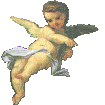
St.
John's Story of the Resurrection of Christ in Italian and English
![]()
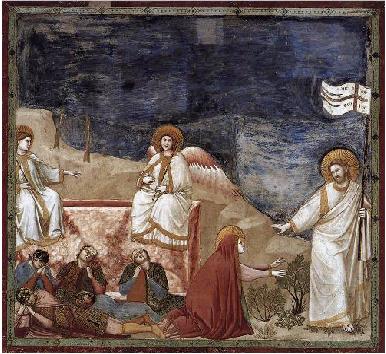
In the Bible's gospel according
to St. John, there is a description of the resurrection of Jesus of
Nazareth, celebrated at Easter by Christians around the world, including
in Italy.

